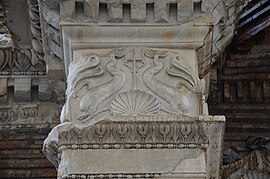You can help expand this article with text translated from the corresponding article in Italian. (December 2015) Click for important translation instructions.
|
 Remains of its decoration, including marine elements. Remains of its decoration, including marine elements. | |
  | |
| Click on the map for a fullscreen view | |
| Coordinates | 41°53′53.76″N 12°28′37.39″E / 41.8982667°N 12.4770528°E / 41.8982667; 12.4770528 |
|---|---|
The Basilica of Neptune (Latin: basilica Neptuni) was a basilica built in Rome by Marcus Vipsanius Agrippa in honour of Neptune and in celebration of his naval victories at Mylae, Naulochus and Actium.
History
Near the site of the Pantheon, its remains were restored under Hadrian for an unknown use. The Temple of Hadrian was once misidentified with the basilica.

It was part of building works on the Campus Martius between 33 and 25 BC, possibly financed by the proceeds of Octavian's campaign in Illyria between 35 and 33 BC. The project also included the Pantheon, the Saepta Iulia and the Baths of Agrippa.
Architecture and decorations
The structure of the Basilica of Neptune is much more similar to the central halls of the imperial baths than to the classic Roman civil basilicas, resembling the 4th century Basilica of Maxentius. The construction, in brick, and the style date back to the Hadrianic period, but the basilica reaches the early Augustan period.
References
- For example, in Eugénie Strong, Roman Sculpture from Augustus to Constantine, 1909, ripubblicato da Ayer Publishing, 1969, ISBN 0405022301, p. 243.
Bibliography
- Lawrence Richardson Jr., s.v. "Basilica Neptuni", in A New Topographical Dictionary of Ancient Rome, Baltimore, JHU, 1992. ISBN 0801843006, p. 54.
External links
- Lucentini, M. (31 December 2012). The Rome Guide: Step by Step through History's Greatest City. Interlink. ISBN 9781623710088.
![]() Media related to Basilica of Neptune (Rome) at Wikimedia Commons
Media related to Basilica of Neptune (Rome) at Wikimedia Commons
| Preceded by Basilica of Maxentius |
Landmarks of Rome Basilica of Neptune |
Succeeded by Basilica Ulpia |